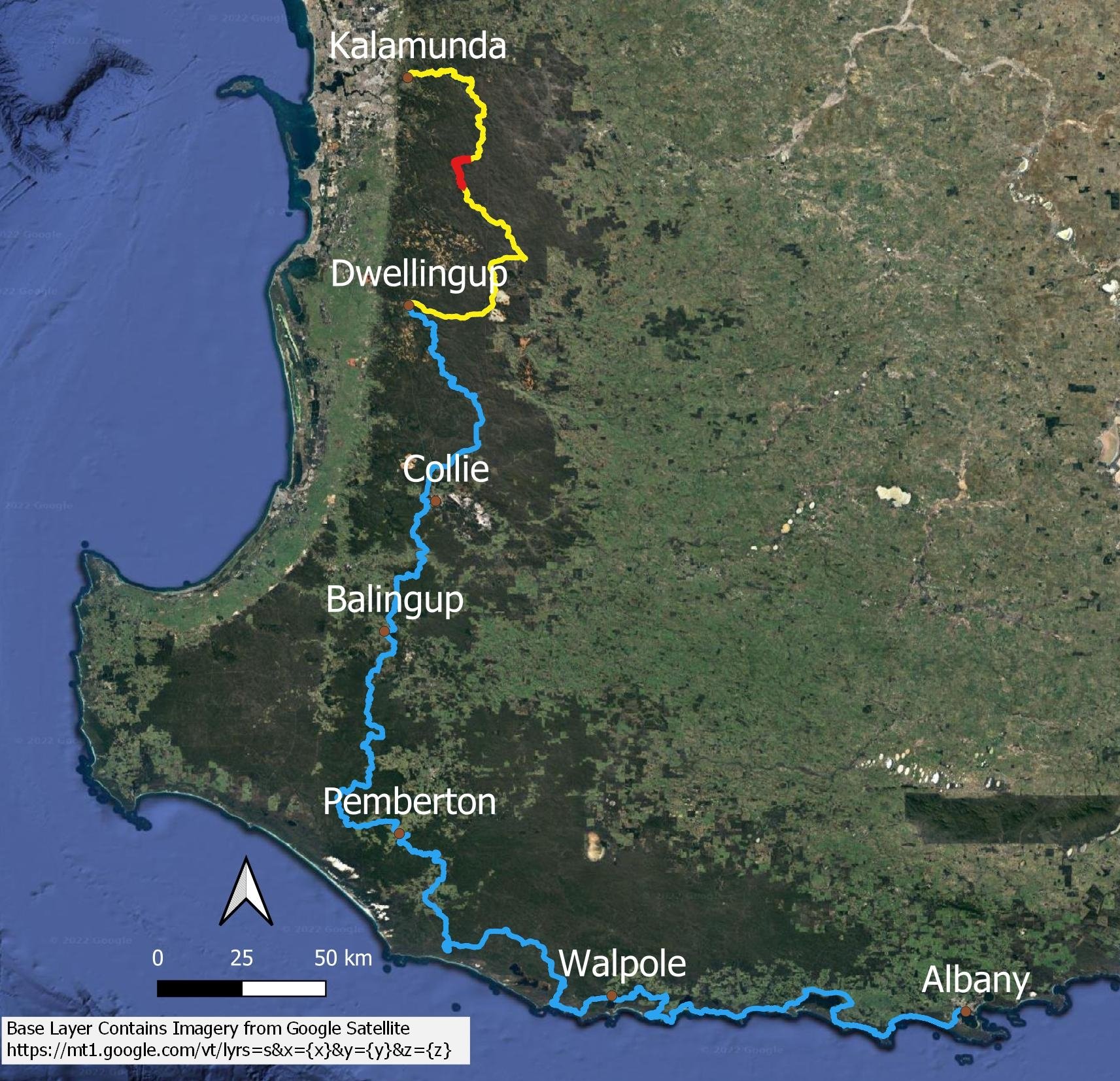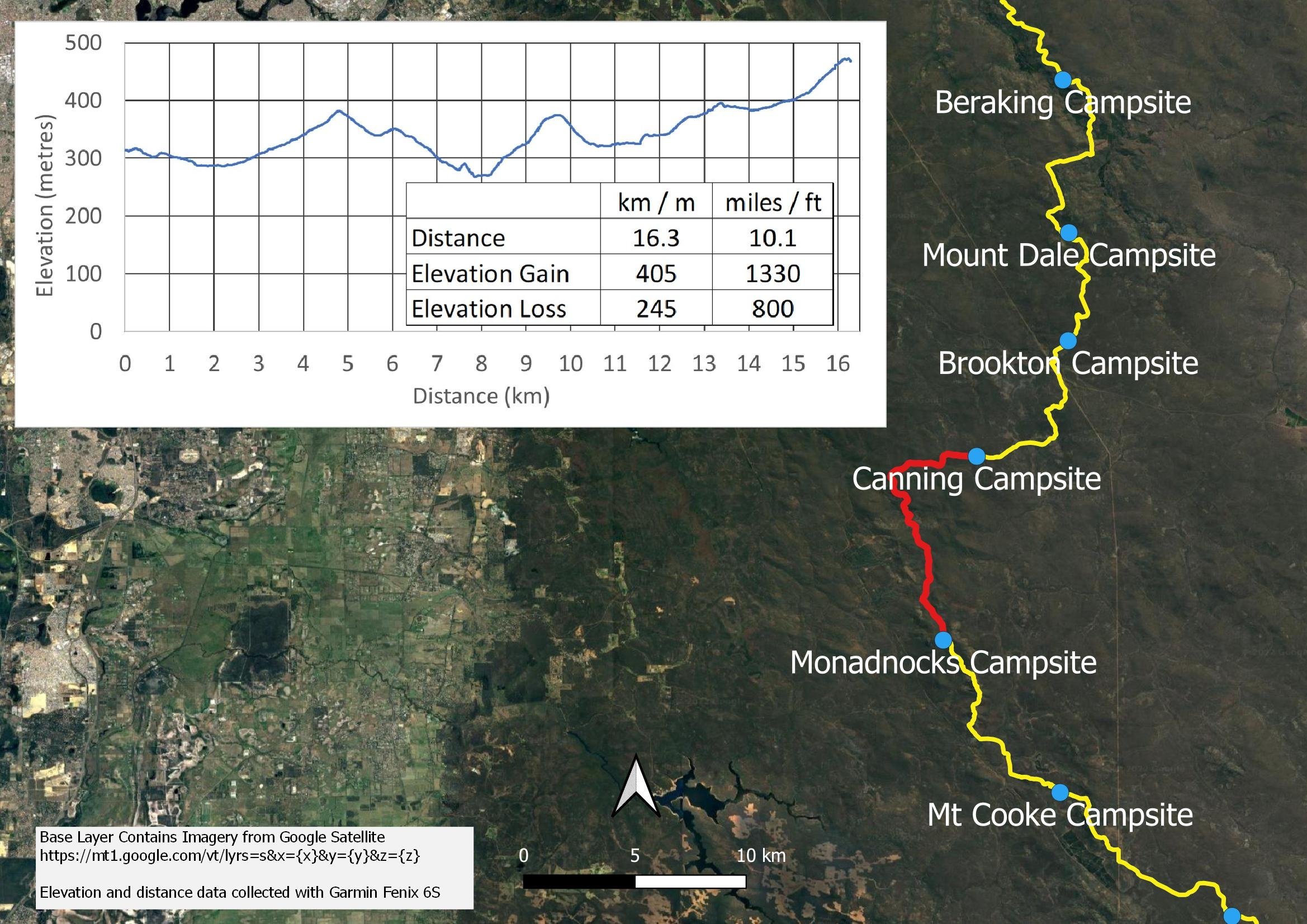Day 9 Canning to Monadnocks, Day 10 Rest Day Monadnocks
We acknowledge the Nyoongar People as the traditional custodians of the land and waters along the Bibbulmun Track
Today we have a mixture of landscapes and, without smoke, it’s a stress-free stroll through wildflowers, open woodland and forest.
The weather has been excellent until now but a change is forecast. As well, although our bodies are holding up well, we are due for a rest day. Before our hikes, Geoff and I train, but different health reasons prevented us from doing so this time. And regardless of your pace or distances, walking day after day is very different from those same distances or longer done on weekends with a break in between, so consider this in your planning. Another option could have been a pickup at Brookton Highway. In any case, we’re at the very start of a long distance hike. It’s important to give our bodies time to acclimatise to the new daily regime. Many hikers go like a bull at a gate at the start, only to be sidelined by injuries a week or two in, or to get discouraged because they’re hurting too much to have fun. We don’t want that to happen!
Our overview map for the day…
the first of the slightly longer distances.
At just over 16km, today’s hike is the first on the Track of a slightly longer distance, with three modest climbs, including a 4km steady ascent at the end of the day.
We’d discussed a rest day with our mentor at the Bibbulmun Track Foundation, and he suggested Monadnocks as a good hut for this, with a delightful outlook and a nice hill (Mt Randall) behind the hut to climb. So we plan to stop at Monadnocks for two nights: ‘double-hutting’ slowerhiking style! This turns out to be an excellent decision for unanticipated reasons.
After yesterday’s excitement, it’s great to go back to our usual leisurely style and take note of interesting bits and bobs on our path. Here, endemic Corymbia nuts that have been eaten, which we don’t see in South Australia with introduced native Corymbias – our local cockatoos might need another ten thousand or so years to evolve!
Pleasant walking. And just look at that sky! We’ve had showery days but no extended rain. It can’t last but we appreciate it.
Most of the signage comprises the tiny triangular wauguls, but often road crossings have larger ones
Regrowth is sufficiently dense to obscure views. We take each bit as it comes.
Conostylis setosa
The bull banksias are amazing with their distinctive leaves. They are incredibly sensitive to the introduced root pathogen phytophthera cinnamoni which can be carried on hiking boots, so sticking to the track in these areas is worth doing so as not to infect pristine stands like these.
It’s great coming across the more open granite areas – as we saw yesterday before being diverted, there are so many different and interesting plants, and it’s nice to have the views open up.
Daisies on granite outcrop
Canning River Bridge
There’s a little beach on the northern bank from which you can take a dip.
Canning River
Hibbertia amplexicaulis
This little case moth caterpillar was crossing the road. We gave it a helping hand.
We stop for lunch – our favourite topping to Geoff’s sourdough crackers is freeze dried feta, rehydrated with a sprinkle of salt and pepper added and a splash of olive oil. It is DELICIOUS!
The leaves of this pea flower, Daviesia cordata, look exactly like young gum leaves
Pterostylis hians in a burnt area just before the hut
View from the hut and through the trees to Mt Cuthbert, where we’ll head after our rest day.
Our campsite. There are quite a few but they are all very lightly sloping, which turns out not to be a problem. Behind the tent, just out of sight and to the right, is a hill we plan to climb tomorrow.
Another view of the campsite. You can just see another off to the right, connected by a little path. There’s another a similar distance away downhill. This turns out to be quite significant!
Day 10 Rest Day: Our kind of Double Hutting!
The rain buckets down during the night and when we stick our heads out of the tent it is still gloomy. Shortly afterwards, the rain is again pouring down. We’re in no hurry to get up but can hear our friends breaking camp in the hut, and the rain hammering on the tin roof is so loud that we can also hear it from where we are.
After a while we get up and make our way to the hut. The ground is drenched, the views non- existent. So glad not to be hiking today, not so much because of the rain but because the next section of track is famous for its views. There will be none today: the cloud is scarcely above tree height. We wave off our friends, thoroughly bundled in their rain gear.
I rummage in the box in the hut and unearth the perfect book to snuggle up with: Fuchs and Hillary’s “The Crossing of Antarctica”. Their travails make me feel quite cosy!
Geoff works his way through the Bibbulmun magazines – there’s always a stash of them in the box. Though we’re not quite experiencing the track “In Comfort”,
at least we’re dry!
We took a polycro footprint instead of Tyvek on this trip to save weight but we’ve just about had it with the stuff. It turns into scrunched cling wrap when wet and is similarly difficult to flatten. You can see the wrinkled film of our vestibule triangle in the vestibule.
Because previous campers have assiduously raked campsites clear of any leaf matter, there’s a LOT of splashback, where rain hitting the hard ground throws up mud. It’s all on the outside of the tent – zero enters – but our tent is grotty.
As well, our tent floor is either leaking, seeping, or there is condensation between the mat and floor. Any of these are possible. Later we see that the underside of the tent floor above the polycro is also wet, with moisture under our mats, so water from the splashback has either seeped between the layers or the polycro has microabrasions. The moisture under our mats could be condensation, or our Triplex floor is faulty, or we have damaged it. The ground here is incredibly rough, second only to sharp limestone. It’s quite possible our polycro and floor have been damaged. We decide to order more Tyvek in the next town – we don’t want to further damage our tent floor if, indeed, we have.
And there is definitely a leak in the corner of the tent. This is annoying as this Triplex is a free replacement for our previous one, which had a door that wouldn’t tension: when we measured it, it was a different size so there must have been a sewing or cutting error in the factory. However, big bouquets to Zpacks for replacing the tent when we sent a video showing the problem.
This time the leak, unlike a few nights ago, isn’t user error: it is seeping through somewhere around the pleated corner fold. It’s only minor with perhaps a tablespoon of water, so we can just tuck a microfibre cloth in the corner, but not really acceptable for an AUD$1000+ tent. It continues to leak in the same way and in the same place for the rest of our trip, and we can’t find the exact spot, which is infuriating because it would be an 100% easy fix with a bit of DCF tape, which we have in our repair kit.
Our Duplex, in which we have had countless nights, has never leaked like this, and we’ve honed the setup so we understand these tents’ quirks. The new fabric tape along the corner seam of the Triplex mesh prevents the latter from being overstretched, but it’s also absorbent and wicks water so, in rain, it’s essential to have a steeper downward angle than on our previous zpacks tents. But we did this with our current pitch, so that’s not the cause. Oh well, it’s not a major issue.
We are very glad not to be hiking today: there will be no views whatsoever. And hiking up the hill behind the hut has also lost its appeal.
Late in the afternoon, a group of older teens arrive. They are, without exception, completely drenched. They set up their tents around us. But they are typical teens and soon they are laughing around the campfire, which took a not inconsiderable time to light.
Two lads in the tent a few metres below us have clearly been paired for learning opportunities. They do not like each other much and their conversation is a wonderful source of entertainment. The girls in the tent above us bring memories flooding back, too. I’m glad I’m no longer that age!
One of the two boys has a drenched sleeping bag. His partner takes great delight in luxuriating in his own dry gear. There is a furious rustling, as of a giant chip packet, at about 10pm as the wet lad wraps himself in an emergency sheet that they decide must be at least ten square metres.
The next morning, one of the teachers tells me the kids are nearly adults; they’d been given a list of what to bring but it was important that they experienced the consequences of their choices. We understand this, but it’s also incredibly disappointing because, from the kids’ conversation, not one of them wants to do an overnight hike ever again.































